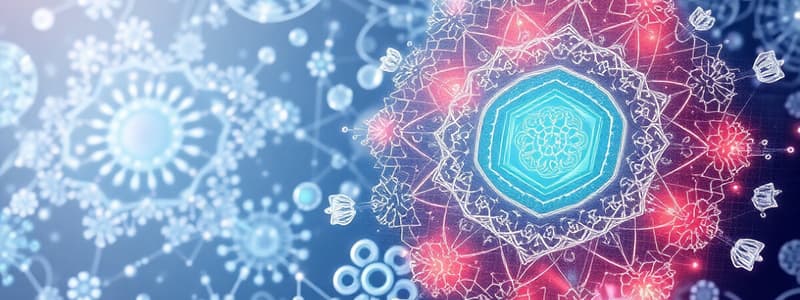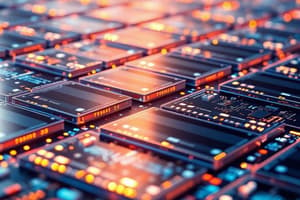Podcast
Questions and Answers
What is the first step in the semiconductor wafer fabrication process?
What is the first step in the semiconductor wafer fabrication process?
- Slicing
- Polishing
- Ingot Growth
- Converting sand to silicon (correct)
Which material is commonly used in the production of semiconductor wafers?
Which material is commonly used in the production of semiconductor wafers?
- Aluminum
- Silicon (correct)
- Plastic
- Copper
How many individual steps are generally involved in the production process of semiconductor wafers?
How many individual steps are generally involved in the production process of semiconductor wafers?
- 300 (correct)
- 200
- 350
- 250
What is one of the critical roles of foundries in technology?
What is one of the critical roles of foundries in technology?
What is the purpose of the polishing step in wafer fabrication?
What is the purpose of the polishing step in wafer fabrication?
In which step of wafer fabrication is silicon sliced?
In which step of wafer fabrication is silicon sliced?
What aspect of foundries is highlighted as critical in the modern world?
What aspect of foundries is highlighted as critical in the modern world?
Which of the following statements is FALSE regarding the semiconductor fabrication process?
Which of the following statements is FALSE regarding the semiconductor fabrication process?
What is the primary purpose of the edge grinding procedure in silicon wafer manufacturing?
What is the primary purpose of the edge grinding procedure in silicon wafer manufacturing?
How much can the polishing step reduce breakage in the silicon wafers?
How much can the polishing step reduce breakage in the silicon wafers?
What is the highest clean room class rating in terms of cleanliness?
What is the highest clean room class rating in terms of cleanliness?
What is the main function of the stock removal process during polishing?
What is the main function of the stock removal process during polishing?
What aspect is primarily focused on during the final polish of the wafer?
What aspect is primarily focused on during the final polish of the wafer?
Which stage in the polishing process does not remove material?
Which stage in the polishing process does not remove material?
What is the main requirement for workers in a clean room?
What is the main requirement for workers in a clean room?
What typically happens during a backside scrub of the wafer?
What typically happens during a backside scrub of the wafer?
What is the primary material used to create silicon wafers?
What is the primary material used to create silicon wafers?
What is the main advantage of using larger silicon wafers in semiconductor production?
What is the main advantage of using larger silicon wafers in semiconductor production?
What is the primary purpose of the Siemens process in silicon refinement?
What is the primary purpose of the Siemens process in silicon refinement?
At what temperature range is the reaction of silicon and hydrochloric acid conducted in the Siemens process?
At what temperature range is the reaction of silicon and hydrochloric acid conducted in the Siemens process?
What is the temperature required to reduce SiO2 to form silicon in the furnace process?
What is the temperature required to reduce SiO2 to form silicon in the furnace process?
What is the outcome of the reduction of purified trichlorosilane in the final step of the Siemens process?
What is the outcome of the reduction of purified trichlorosilane in the final step of the Siemens process?
What type of silicon is produced as a result of the submerged electrode arc furnace process?
What type of silicon is produced as a result of the submerged electrode arc furnace process?
What is the energy bandgap of silicon, allowing it to effectively control electrical currents?
What is the energy bandgap of silicon, allowing it to effectively control electrical currents?
What happens to the silicon carbide (SiC) during the reduction process in the furnace?
What happens to the silicon carbide (SiC) during the reduction process in the furnace?
What structure does raw electronic-grade silicon have, making it unsuitable for semiconductor manufacturing?
What structure does raw electronic-grade silicon have, making it unsuitable for semiconductor manufacturing?
Which technique is NOT used to turn polycrystalline silicon into single crystals?
Which technique is NOT used to turn polycrystalline silicon into single crystals?
Which property of silicon aids in its reliability over various temperatures?
Which property of silicon aids in its reliability over various temperatures?
What are silicon wafers primarily used for?
What are silicon wafers primarily used for?
Which impurity affects the color of sand used in the construction industry?
Which impurity affects the color of sand used in the construction industry?
What characteristic of silicon dioxide (SiO₂) is crucial for semiconductor applications?
What characteristic of silicon dioxide (SiO₂) is crucial for semiconductor applications?
What happens during the Czochralski Process at the melting point of silicon?
What happens during the Czochralski Process at the melting point of silicon?
Which property of a single silicon crystal is essential for semiconductor devices?
Which property of a single silicon crystal is essential for semiconductor devices?
Why is silicon considered a cost-effective material in semiconductor manufacturing?
Why is silicon considered a cost-effective material in semiconductor manufacturing?
What role does the seed crystal play in growing an ingot of silicon?
What role does the seed crystal play in growing an ingot of silicon?
What mature processing technique is commonly used for silicon in the semiconductor industry?
What mature processing technique is commonly used for silicon in the semiconductor industry?
During the Czochralski Process, what is the effect of rotating the seed crystal and crucible in opposite directions?
During the Czochralski Process, what is the effect of rotating the seed crystal and crucible in opposite directions?
How does the scalability of silicon benefit the production of electronic devices?
How does the scalability of silicon benefit the production of electronic devices?
What supports the high-volume production of silicon-based products?
What supports the high-volume production of silicon-based products?
Which of the following advantages does silicon NOT have for semiconductor applications?
Which of the following advantages does silicon NOT have for semiconductor applications?
Flashcards are hidden until you start studying
Study Notes
Silicon Wafers
- Silicon is a metalloid with the symbol Si and atomic number 14.
- Due to its unique properties, Silicon is essential in the semiconductor industry.
- Silicon wafers are thin, flat discs of silicon that are used as a substrate for fabricating integrated circuits.
- The size of wafers range from 1 inch to 300mm with a thickness of 0.7mm.
- Larger wafer sizes allow for the production of more chips simultaneously, which results in increased production at a lower cost.
Properties of Silicon
- Silicon has an energy bandgap of 1.1 electron volts (eV), which makes it ideal for semiconductors as it allows it to control electrical current across a wide range of voltages and frequencies.
- Silicon is abundant and cost-effective as it's the second most abundant element on Earth.
- The semiconductor industry has developed efficient processing techniques for silicon, including the Czochralski method and photolithography.
- Silicon has high thermal conductivity, which aids in heat dissipation, and it forms a durable layer of silicon dioxide that provides excellent electrical insulation.
- Silicon supports the integration of billions of transistors on a single chip, enabling the production of high-performance microprocessors and memory devices.
- The supply chain for silicon is well-established, with a global infrastructure supporting mass production.
Wafer Fabrication Process
- The wafer fabrication process requires over 300 individual steps.
- The process begins with the conversion of sand (silicon dioxide, SiO2) into silicon.
- The starting material for Si manufacture is quartzite or sand.
- Sand used in building industry is often impure, but pure silica sand is used for silicon manufacture.
- The silicon is purified through a process called the Seimens process, which involves reacting the Si with HCL gas to form trichlorosilane, which is then purified through fractional distillation and reduced using hydrogen gas.
- The resulting product is electronic grade silicon—nearly 100% pure Si.
- The polycrystalline electronic-grade silicon is then turned into single crystals through the Czochralski Process or the Float Zone technique.
- The silicon ingot is cut into thin wafers, which are then polished and cleaned in a dust-free clean room.
- The polishing process involves using polishing pads and polishing slurry to remove a thin layer of silicon, leaving a mirror finish.
- During the final polishing step, there is no removal of material.
- Wafers are then cleaned and packaged for use in the fabrication of integrated circuits.
Czochralski Process
- The silicon is heated above its melting point (1412°C).
- A seed crystal is positioned on top of the melt, with the same crystal orientation required in the finished ingot.
- The seed and molten silicon crucible rotate in opposite directions to ensure doping uniformity.
Wafer Cleaning and Polishing
- The wafer cleaning and polishing process takes place in a highly controlled clean room environment.
- The clean room rating system ranges from Class 1 to Class 10,000, indicating the number of particles per cubic foot.
- Workers in clean rooms wear clean room suits to prevent contamination.
- Typically, wafers are polished on the front side only, with 300mm wafers being polished on both sides.
- The polishing process involves two steps: stock removal and final chemical mechanical polish (CMP).
- The final polishing step leaves a mirror finish on the wafer.
Studying That Suits You
Use AI to generate personalized quizzes and flashcards to suit your learning preferences.




